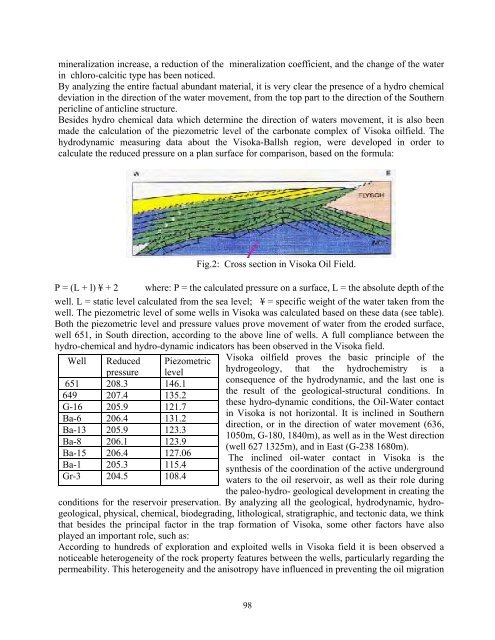DYNAMICS and ACTIVE PROCESSES - International Lithosphere ...
DYNAMICS and ACTIVE PROCESSES - International Lithosphere ...
DYNAMICS and ACTIVE PROCESSES - International Lithosphere ...
Create successful ePaper yourself
Turn your PDF publications into a flip-book with our unique Google optimized e-Paper software.
mineralization increase, a reduction of the mineralization coefficient, <strong>and</strong> the change of the water<br />
in chloro-calcitic type has been noticed.<br />
By analyzing the entire factual abundant material, it is very clear the presence of a hydro chemical<br />
deviation in the direction of the water movement, from the top part to the direction of the Southern<br />
pericline of anticline structure.<br />
Besides hydro chemical data which determine the direction of waters movement, it is also been<br />
made the calculation of the piezometric level of the carbonate complex of Visoka oilfield. The<br />
hydrodynamic measuring data about the Visoka-Ballsh region, were developed in order to<br />
calculate the reduced pressure on a plan surface for comparison, based on the formula:<br />
�<br />
Fig.2: Cross section in Visoka Oil Field.<br />
P = (L + l) ¥ + 2 where: P = the calculated pressure on a surface, L = the absolute depth of the<br />
well. L = static level calculated from the sea level; ¥ = specific weight of the water taken from the<br />
well. The piezometric level of some wells in Visoka was calculated based on these data (see table).<br />
Both the piezometric level <strong>and</strong> pressure values prove movement of water from the eroded surface,<br />
well 651, in South direction, according to the above line of wells. A full compliance between the<br />
hydro-chemical <strong>and</strong> hydro-dynamic indicators has been observed in the Visoka field.<br />
Well Reduced Piezometric<br />
pressure level<br />
651 208.3 146.1<br />
649 207.4 135.2<br />
G-16 205.9 121.7<br />
Ba-6 206.4 131.2<br />
Ba-13 205.9 123.3<br />
Ba-8 206.1 123.9<br />
Ba-15 206.4 127.06<br />
Ba-1 205.3 115.4<br />
Gr-3 204.5 108.4<br />
Visoka oilfield proves the basic principle of the<br />
hydrogeology, that the hydrochemistry is a<br />
consequence of the hydrodynamic, <strong>and</strong> the last one is<br />
the result of the geological-structural conditions. In<br />
these hydro-dynamic conditions, the Oil-Water contact<br />
in Visoka is not horizontal. It is inclined in Southern<br />
direction, or in the direction of water movement (636,<br />
1050m, G-180, 1840m), as well as in the West direction<br />
(well 627 1325m), <strong>and</strong> in East (G-238 1680m).<br />
The inclined oil-water contact in Visoka is the<br />
synthesis of the coordination of the active underground<br />
waters to the oil reservoir, as well as their role during<br />
the paleo-hydro- geological development in creating the<br />
conditions for the reservoir preservation. By analyzing all the geological, hydrodynamic, hydrogeological,<br />
physical, chemical, biodegrading, lithological, stratigraphic, <strong>and</strong> tectonic data, we think<br />
that besides the principal factor in the trap formation of Visoka, some other factors have also<br />
played an important role, such as:<br />
According to hundreds of exploration <strong>and</strong> exploited wells in Visoka field it is been observed a<br />
noticeable heterogeneity of the rock property features between the wells, particularly regarding the<br />
permeability. This heterogeneity <strong>and</strong> the anisotropy have influenced in preventing the oil migration<br />
98<br />
�




